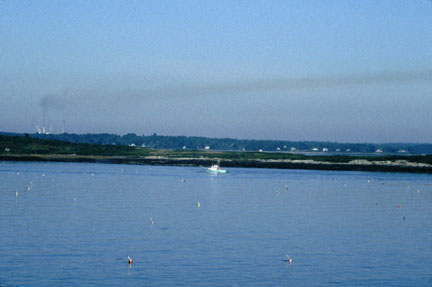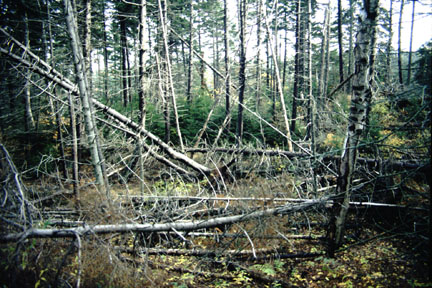 |
|
 |
|
|
Maine is downwind of the 105 dirtiest coal-fired power plants in the U.S., most of which are located in the Ohio River Valley. One is in Bow, New Hampshire, five in New York, 21 in Pennsylvania. They're so dirty they're listed by name in the Clean Air Act of 1990. Each year EPA auctions to the highest bidder about 250,000 pollution allowances that enable these plants to emit one ton of sulfur dioxide and keep running. The Acid Rain Retirement Fund (A.R.R.F.) competes with owners of power plants nationwide to purchase these allowances. A non-profit, all-volunteer, community group, A.R.R.F. bids alongside polluters for as many allowances as it can afford. But instead of using them, A.R.R.F. retires them permanently, taking allowances off the market and keeping sulfur dioxide out of the air.  Wyman Station, an ancient oil-fired power plant was built just north of Portland in the 1950s before pollution controls were required. It was not listed in the Clean Air Act of 1990 because CMP kept it on standby, using it only in emergencies. Recently Florida Power & Light bought it and wants to use it all the time, increasing local air pollution. A.R.R.F. does not support the purchase of emissions allowances by electric utilities like FP&L so they can pollute more. A.R.R.F. buys up emissions allowances so utilities like FP&L can't use them. Sulfur dioxide and nitrogen oxides are the principal contributors to acid rain that falls in Maine, aggravating respiratory disorders, impairing visibility, harming the health of our forests and lakes, fish and wildlife. Most SO2 emissions come from combustion of coal and oil or the smelting of nonferrous metals like copper and nickel. Because these materials contain trace impurities, their use concentrates a number of contaminants in acid rain, including oxides of nitrogen and sulfur, toxic heavy metals such as lead, cadmium and mercury, and several organic pollutants like alkanes, PCB's, and volatile organic compounds, some of which are known to cause cancer. 
When acid rain falls on forest land, it leaches nutrients and reduces soil productivity. Phosphorous, potassium, magnesium and calcium needed for plant and tree growth are mobilized by increased acidity of soil moisture. As nutrients are leached away, the growth of some species slows, reducing agricultural production and growth rates of some trees. Increased acidity of soil moisture also mobilizes some toxic metals normally occurring in most forest soils, including zinc, manganese and aluminum. Usually benign in trace amounts, research has shown elevated concentrations of these metals in acidic soils damage fine root hairs of some commercial tree species, retarding growth. Lost nutrients and mobilized toxic metals are important because reduced tree growth means reduced harvests under sustainable forestry practices. Thus the linkage between acid rain and sustainable forestry is direct and immediate: More acid rain means less sustainable forestry. Rain is considered abnormally acidic when it has pH below 5.0, and lakes are considered acidified with pH of less than 5.5. The pH of rain and snow in Maine varies seasonally between 3.9 and 5.0 (normal pH of rainfall elsewhere is about 5.5). The pH of precipitation was 4.3 at Acadia National Park, 4.6 at Bridgeton and Caribou, and 4.5 at Greenville in August 2000. About 100 lakes in Maine have pH lower than 5.5. About half are naturally acidic; the other half have elevated levels of acidity due to human causes like acid rain, according to the Maine Department of Environmental Protection. 
Elevated acidity makes lake water appear crystal clear because most algae and microorganisms die off. Aquatic communities of plants and animals change as sensitive species diminish for lack of food or inability to reproduce. The most popular fish species - trout, salmon and small-mouth bass - are often the most sensitive and the first to go. Consequently, A.R.R.F. members enjoy retiring emissions allowances. In March 2000 the EPA sold allowances to emit 253,388 tons of sulfur dioxide in its annual auction. The owner of several coal-fired power plants in the Ohio River Valley, American Electric Power Company, paid nearly $15.5 million for 169,776 tons. Nine other electric utilities bought most of the rest. The Acid Rain Retirement Fund acquired the legal right to emit 13 tons of sulfur dioxide beginning in 2000. This may not sound like much, unless one considers that one ton of sulfur dioxide is enough to kill any lake in Maine. Along with allowances purchased in prior years, A.R.R.F. now owns the right to emit 53 tons of sulfur dioxide per year, every year. Because A.R.R.F. didn't pollute during 1996-2000, "banking" its emissions allowances for the future, it now owns the right to emit a total of 216 tons of sulfur dioxide next year. Examination of EPA Allowance Auction results 1993-2000 indicates 62 groups or individuals have purchased 1,019 tons of sulfur dioxide emissions allowances for purposes other than emitting air pollution. This is more than the 720 tons/year provided by law for the Miami Fort #5 generating unit in Ohio. Since many purchases were made in earlier years, and unused allowances have accumulated, these groups now own the right to emit 5,757 tons of sulfur dioxide in 2001. This is more than the annual allocation of allowances for 22 out of the 105 dirtiest generating units in the United States. Small actions add up. Contributors of $25 or more to A.R.R.F. receive a Clean Air Certificate in their name saying how much air pollution their donations retire. A.R.R.F. is accepting donations for the next EPA Auction in March 2001. Emissions allowances were recently selling for $150/ton, or about 7.5 cents/pound! At that rate, a $10 membership donation to A.R.R.F. will retire about 133 pounds of air pollution. A.R.R.F. is incorporated as a Section 501(c)(3) nonprofit educational organization in the State of Maine, and contributions are tax-deductible. For more information, visit the A.R.R.F. website at www.usm.maine.edu/~pos/arrf.htm or write: Acid Rain Retirement Fund, P.O. Box 10272, Portland, ME 04104. Michael Hamilton is instigator and Secretary/Treasurer of A.R.R.F., and teaches environmental policy at the University of Southern Maine, where he Chairs the Political Science Department. For more about acid rain and Maine's forests also see Tree Death and Forest Decline by Paul Donahue. |
283 Water Street, 3rd floor, P.O. Box 2118, Augusta, Maine 04338 phone: 207-628-6404 fax - 207-628-5741 email: fen@powerlink.net